Neighbouring Colombia and Peru, Ecuador is a relatively small country that nevertheless offers an enticing array of scenic landscapes, diverse wildlife species and interesting cities. Dense Amazon rainforest, towering Andean mountain peaks, palm-fringed Pacific Coast beaches and fascinating historical sites are all part and parcel of Ecuador’s prolific charms. The former Inca town of Cuenca is the nation’s third-largest city and a Unesco World Heritage Site. This alluring city, with its cobbled streets, beautiful architecture and photogenic plazas, boasts a huge variety of museums and art galleries. The vibrant capital city of Quito is also worth a visit. Arguably the most dazzling jewel in Ecuador’s crown is the Galapagos Archipelago in the Pacific, about 1000 kilometres west of the mainland. Their magnificent, pristine landscapes and prolific wildlife, which inspired Charles Darwin, have made this cluster of islands a world-famous travel destination.
Quito, the capital of Ecuador, lies on the slopes of the Andes’ mighty Pichincha volcano in the Guayllabamba river basin. The city’s Old Town is its main attraction - one of the most well preserved in Latin America and the first-ever UNESCO heritage site. Wander among ancient, colourful streets; pop into glorious historic churches; or spend an afternoon browsing the vibrant Mercado (markets) and learning about the unique, traditional Ecuadorian Sierra culture. Other bucket list items in Quito include a visit to the impressive Casa Museo Guayasamín; the Museo de la Presidencia which provides insight into Ecuador’s history; and a climb up the iconic towers of the Basilica. Numerous gorgeous public parks and a thriving and exciting culinary scene complete the package.
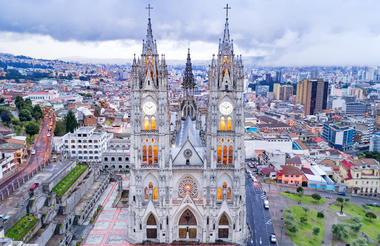
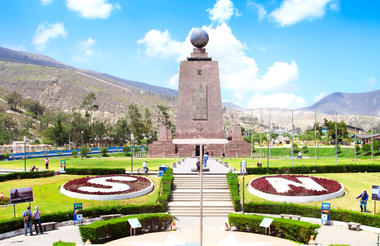
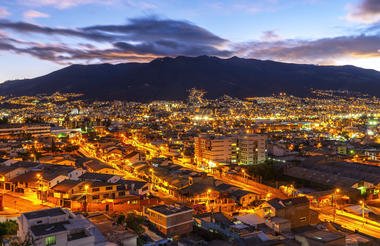
The Ecuadorian province of Orellana lies along the northeastern border and is located very close to the Amazon rainforests, near the confluence of the Coca and Napo Rivers. It serves as an ideal base for jungle adventures and discovering the cultures of the indigenous people - the Taguareis, Kichwa, and Sachas tribes live here, some in their native forests. Start by visiting the Museo Arqueologico Centro Cultural Orellana to gain insight into thousands of years of forest culture. There are also wonderful traditional villages to explore. Primary attractions include the Yasuni National Park, the Cuyabeno Wildlife Reserve, and the Sumaco Napo-Galeras National Park. The province’s name and capital city, Puerto Francisco de Orellana, was inspired by the El Dorado explorer Francisco de Orellana. From Orellano, visitors can take boats to Peru, Colombia, and Brazil.



As previously described



Established in 1975 as a protected area, Cotopaxi National Park – situated about 50km southeast of the capital Quito – represents the most impressive of what Ecuador has to offer by way of animals and birds, including the majestic Andean condor, as well as magnificent photographic opportunities in the form of spectacular valleys, lakes and a number of volcanoes. Centre stage is occupied by the snow-laden Cotopaxi volcano that rises to 5 890m – a favourite with mountaineers. An excursion might have you spying puma, the rare Andean spectacled bear, Andean fox or orange-headed caracara, which is endemic in the area. The ruins of Incan forts and other ancient stone building remains can be seen surrounding Santo Domingo Lake.



Located in central Ecuador in the Chamba River Valley of the Andes, Riobamba lies at the heart of an extensive scenic road network and is the starting point of the well-known historic train ride down the spectacular Nariz del Diablo or ‘Devil’s Nose’. The city, sometimes referred to as the ‘Sultan of the Andes’, is an important commercial centre for the central highlands and due to its proximity to Chimborazo, the country’s highest peak, is also a favourite base for trekkers and mountain climbers. On Saturdays, visitors can enjoy the large bustling market that brings traders from far and wide to sell a rich assortment of wares.



Cuenca is a vibrant city set in the Ecuadorian Highlands, and is the capital of the Azuay Province. Ancient history tells of an impressive Incan centre with the finest temples covered in gold sheets and magnificent palaces, but little remains of this glory. The town’s present-day charm is due largely to its impressive colonial architecture, cobbled streets, plazas, and churches – including the blue-domed Cathedral of the Immaculate Conception – and its setting above the grassy banks of the Rio Tomebamba. The town centre was declared a UNESCO World Heritage Site in 1999 and is a popular place of inspiration for writers, poets, and artists.



Resting on the west bank of the Guayas River, Guayaquil is the largest and most populous city in Ecuador is also its main port and economic hub. It has also carved a rich identity for itself with a number of urban renewal projects that have transformed it into an extremely appealing destination. While visitors can still enjoy the colonial grandeur of sites like the Guayaquil Metropolitan Cathedral and the historic Las Peñas quarter, the city’s modern offerings include The Malecon, a bustling 2.5km riverfront walkway and the Museo Antropologico y de Arte Contemporaneo – a must for art lovers. The protected area of Santay Island offers a taste of local village life. Guayaquil is also the departure point for trips to the Galápagos Islands.
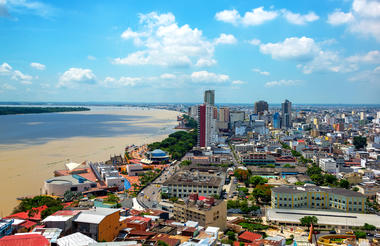
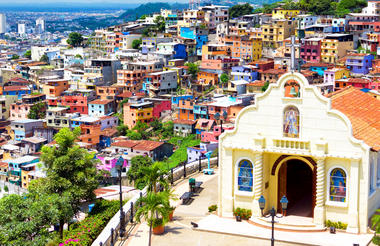
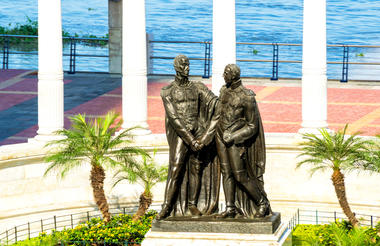
The Galapagos Islands are an archipelago of volcanic islands off the coast of Ecuador, renowned for their amazing endemic species, especially the giant tortoises which give the islands their name. Only discovered in the 1800s, the islands are a UNESCO World Heritage Site and the surrounding waters are a national park and biological marine reserve. Of the 18 islands Baltra, Floreana, Isabela, San Cristobal, and Santa Cruz are now populated by more than 25 000 people. The original names were given by an English pirate, but the Ecuadorians have given the islands Spanish names. The Islands were made famous by Charles Darwin after he visited them on his scientific voyage on the HMS Beagle, and the endemic species here contributed significantly to Darwinian Theory.








